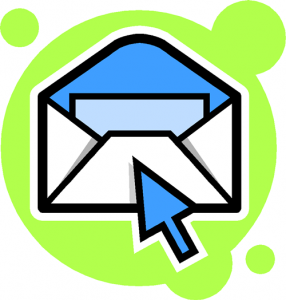 To read all the hype about social media marketing, you might begin to think that traditional communications don’t matter anymore. That couldn’t be further from the truth. Social media is nothing more than a new way to reach customers and influencers, and it is very effective in the right circumstances. However, human behavior has not been changed that much in the last five years, and we shouldn’t forget the value of two stalwarts: e-mail and the press release.
To read all the hype about social media marketing, you might begin to think that traditional communications don’t matter anymore. That couldn’t be further from the truth. Social media is nothing more than a new way to reach customers and influencers, and it is very effective in the right circumstances. However, human behavior has not been changed that much in the last five years, and we shouldn’t forget the value of two stalwarts: e-mail and the press release.
Let’s start with the trusty press release. In his book, The New Rules Of Marketing & PR, David Meerman Scott points out that Yahoo changed the rules of marketing more than a decade ago when it elected to define press releases as news. Google followed suit and the PR profession has never been the same since. Today, many company searches on Yahoo or Google News turn up Business Wire copy as the top result. Likewise, the raw news feeds syndicated on thousands of publishing platforms across the Internet make little or no distinction between the Associated Press and PR Newswire.
That’s why press releases are still so relevant. Their newsy style, headlines, subheads and inverted-pyramid structure give them a distinctive format that satisfies certain kinds of information needs. These same factors also imbue them with outstanding search engine performance. Press releases are basically magnets for search engines because they have all the elements that those engines value most.
Think of press releases as the archival record of events at your company. Assign them a special place on your website where they form a timeline of your company’s history. Keep them brief, stick to the facts and move the nuance and discussion to your social media outposts. Make the press release archive the place that visitors go for official information. For practical value, you still can’t beat this venerable tool.
Permission to Contact
Facebook may be the start page for the under-25 crowd, but for most of us the inbox will be our cyber on-ramp for a long time to come. Just take a look around at your next conference and note how many people are in Outlook or on a BlackBerry.
 E-mail is assuming a new role in this digitally diversified age: that of aggregator. Organizations are spreading their communications across so many social platforms that e-mail is finding new relevance as the one vehicle that ties everything together. It’s also the single most effective medium for communicating with your current customers.
E-mail is assuming a new role in this digitally diversified age: that of aggregator. Organizations are spreading their communications across so many social platforms that e-mail is finding new relevance as the one vehicle that ties everything together. It’s also the single most effective medium for communicating with your current customers.
E-mail has one other huge advantage over most forms of social media: you know who the subscribers are. Members of an opt-in e-mail list give you permission to periodically grab their attention — even if it’s only in a subject line — and deliver a message. No other form of electronic communication carries with it that element of trust.
I encourage clients to embed e-mail subscription forms on every page of their website and take advantage of every opportunity to add subscribers to their e-mail list. If you are managing the relationships well, this list should outperform all others. Just don’t fumble the opportunity by subjecting recipients to sales pitches. Make it useful.
A regular e-mail newsletter is a great place to assemble all of your communications from other channels. Group and organize this information topically and add in some big-picture perspective on fragmented messages. Link back to the source material using unique URLs that you can track in your analytics program. Remember that e-mail is a great way to determine the interests of a set of engaged customers by identifying their click-through behavior.
What do you think? Are new media channels changing the way you use press releases and e-mail marketing?

Great reminder Paul. Obviously I agree!
Paul – Once again, you are brilliant with your point. I’ve made comments about this in certain company, but they scoffed at the idea. When branding, one must not forget all the various audiences for content delivery. Social media is only a certain percantage of readers/viewers. People do actually still watch television on an actual tv in their living rooms and email marketing is still a viable option also.
I’ve recently gone solo again (https://ShannonLane.com) and email marketing is something I’ve added to the mix. Thanks for this article.
Very insightful and dead-on. While running a social media tech company, I sometimes forget the old channels are there and are very effective. Thanks for the reminder. Time to update my iContact list!
Great piece, Paul! Being a tech (PR) veteran, too, I completely agree with your assertion that press releases still have relevance and social media techniques are simply some of the many ‘new’ vehicles with which to promote them… Thanks for the great reminder–especially for those who are trying to make sense of the social media hype.
Paul – Great post and very timely. I was just on a call with one of our Marketing Communications Managers and we were discussing this very subject. Brands are not integrating all the traditional and new communications vehicles into a cohesive strategy and execution plan. Word-of-Mouth or Social Media Marketing still relies on foundational communications tools like brand websites, email marketing, press releases and good, old fashioned mass media. When you integrate them all together, you create a very powerful effort and reach.
Thanks for the insightful and timely post.
I couldn’t agree more. I’m launching a new brand which means building a new brand (www.gettington.com). Social is part of the strategy, but, we will be using all the tools in the marketing toolbox. The imperative is to be consistent, deliberate and sustain. Great post!
Pingback: Press Releases 1.0 and 2.0 | Social Media Strategy | Online PR | Proactive Report | Sally Falkow